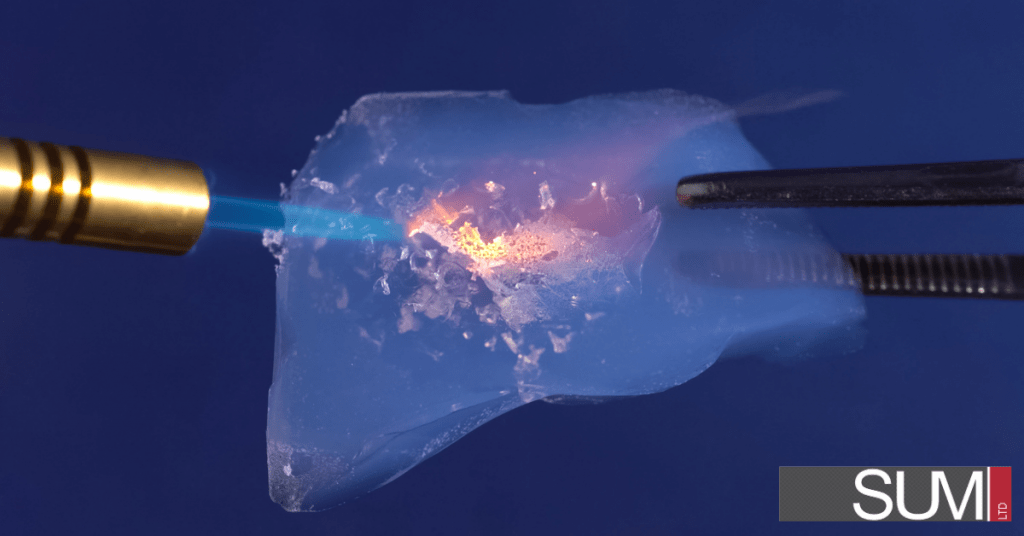What started out as a bet between Dr. Samuel Kistler and Charles Learned at the College of the Pacific in California became the widely used insulation material we know today as aerogel insulation. The bet was as follows: Who could extract liquid out of a gel without shrinkage or contraction and retaining the same structure? In 1931, Dr. Samuel Kistler did just that.
What is Aerogel?
Aerogel is a class of low-density solid gels where the liquid has been replaced with air or gas. While aerogels are typically composed of silica, there are other materials that can be used including carbon, iron oxide, copper, and even gold.
- High porosity: At a nanoscopic level, aerogels have what appears to be a porous, sponge-like structure. This offers aerogels an exceptionally large surface area.
- Low density: Composed of 99.8% air, aerogel has an extremely low density and mass.
- Hydrophilic: Aerogels are hydrophilic (an affinity to water) because its structure is covered in —OH (hydroxy) groups. In fact, aerogels can hold up to 25 times their own weight in water. However, exposing aerogel to water causes the material to lose its structural integrity permanently.
- Low thermal conductivity: Aerogels have a low thermal conductivity because of an effect known as Knudsen diffusion. The mean free path of air molecules travelling through is larger than the width of the aerogel pores, making it difficult for heat to transfer through the material.
- Metallic ring sound: It was observed by Dr. Samuel Kistler that small samples of aerogel emitted a metallic ringing sound.
- Opalescent appearance: Due to its structure, aerogels scatters shorter wavelength like blue in the visible spectrum than longer wavelengths like red or orange in accordance with Rayleigh scattering, providing aerogels its distinct blue hue. In ultraviolet, aerogels appear opaque while in infrared, it appears transparent.
- Rigid and brittle: Aerogel is a hard, rigid material, making it difficult to manipulate. Aerogel is also brittle; drops from even the smallest heights can result in the material shattering.
What are the benefits of using aerogel insulation?
The disadvantages of aerogels can be mitigated by combining it with other materials, forming aerogel insulation. For example, combining aerogel with a composite material like a blanket allows it to be flexible and easily workable. In addition, aerogels can also be combined with a reactive hydrophobe, reversing its hydrophilic property.
Aerogel insulation has several useful benefits:
- High temperatures: Thanks to aerogel’s high porosity and low-density properties, aerogel insulation has superior thermal performance, outperforming wool and fibreglass.
- Thinner insulation blanket: a thinner aerogel insulation blanket can offer the same thermal performance as other types of thicker insulation. This makes installation and removal easier for maintenance and repair personnel, reducing time spent.
- Sub-zero temperature insulation: Aerogel insulation remains pliable even during harsh, frigid conditions, allowing personnel to perform maintenance and repair tasks with greater ease.
- Water-repellent: Combining a reactive hydrophobic compound to aerogel reverses its natural hydrophilic properties, allowing it to handle high humidity conditions.
What are the applications for aerogel insulation?
What used to be available only to NASA with their spacesuits, aerogel has become an increasingly desirable material as industrial insulation for various applications:
Limited space: An aerogel insulation blanket’s thin profile makes it the ideal material to use for compact environments when space is at a premium.
Delicate and/or fragile components: An aerogel insulation blanket’s lightweight property allows it to sit snugly around delicate or fragile components.
High-humidity settings: An aerogel insulation blanket is capable of handling high humidity or marine applications due to its hydrophobic characteristics, making it suitable to protect components against water and corrosion.
Conclusion
Aerogel insulation is an excellent insulation solution when used in specific circumstances and can be integrated into your next custom removable insulation blanket with SUM Ltd. SUM Ltd builds custom-fitted insulation blankets for every project. To us, perfection is the only standard, and a job well done is a blanket that precisely matches every bend, curve, or loop of your instrument. To achieve this, our dedicated staff members always measure and remeasure your instrument. After all, we are firm believers of measuring twice and cutting once.
Our attention to build quality has earned us the trust of companies around the world. You can find our insulation on North Sea drilling platforms, Argentinian instruments, or right at home in BC ships and mines. If your instrument requires custom insulation where space is at a premium, book a consultation with SUM Ltd today to start building your aerogel insulation.
